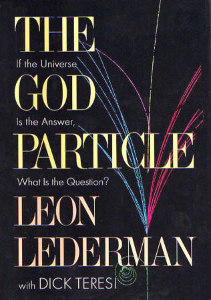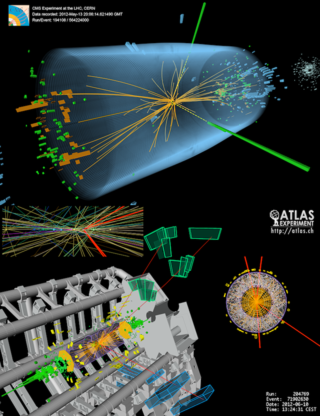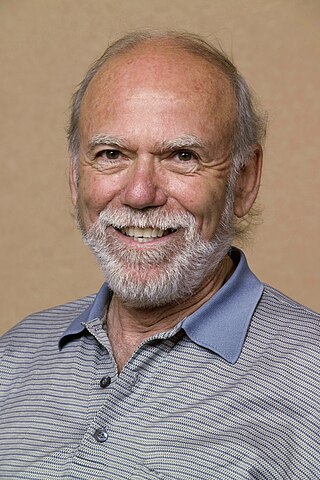
Leon Max Lederman was an American experimental physicist who received the Nobel Prize in Physics in 1988, along with Melvin Schwartz and Jack Steinberger, for research on neutrinos. He also received the Wolf Prize in Physics in 1982, along with Martin Lewis Perl, for research on quarks and leptons. Lederman was director emeritus of Fermi National Accelerator Laboratory (Fermilab) in Batavia, Illinois. He founded the Illinois Mathematics and Science Academy, in Aurora, Illinois in 1986, where he was resident scholar emeritus from 2012 until his death in 2018.

The Big Crunch is a hypothetical scenario for the ultimate fate of the universe, in which the expansion of the universe eventually reverses and the universe recollapses, ultimately causing the cosmic scale factor to reach zero, an event potentially followed by a reformation of the universe starting with another Big Bang. The vast majority of evidence indicates that this hypothesis is not correct. Instead, astronomical observations show that the expansion of the universe is accelerating rather than being slowed by gravity, suggesting that a Big Freeze is more likely. Nonetheless, some physicists have proposed that a "Big Crunch-style" event could result from a dark energy fluctuation.

The Large Hadron Collider (LHC) is the world's largest and highest-energy particle collider. It was built by the European Organization for Nuclear Research (CERN) between 1998 and 2008 in collaboration with over 10,000 scientists and hundreds of universities and laboratories across more than 100 countries. It lies in a tunnel 27 kilometres (17 mi) in circumference and as deep as 175 metres (574 ft) beneath the France–Switzerland border near Geneva.

The Superconducting Super Collider (SSC) was a particle accelerator complex under construction in the vicinity of Waxahachie, Texas, United States.

The Relativistic Heavy Ion Collider is the first and one of only two operating heavy-ion colliders, and the only spin-polarized proton collider ever built. Located at Brookhaven National Laboratory (BNL) in Upton, New York, and used by an international team of researchers, it is the only operating particle collider in the US. By using RHIC to collide ions traveling at relativistic speeds, physicists study the primordial form of matter that existed in the universe shortly after the Big Bang. By colliding spin-polarized protons, the spin structure of the proton is explored.

The International Linear Collider (ILC) is a proposed linear particle accelerator. It is planned to have a collision energy of 500 GeV initially, with the possibility for a later upgrade to 1000 GeV (1 TeV). Although early proposed locations for the ILC were Japan, Europe (CERN) and the USA (Fermilab), the Kitakami highland in the Iwate prefecture of northern Japan has been the focus of ILC design efforts since 2013. The Japanese government is willing to contribute half of the costs, according to the coordinator of study for detectors at the ILC.

High-energy nuclear physics studies the behavior of nuclear matter in energy regimes typical of high-energy physics. The primary focus of this field is the study of heavy-ion collisions, as compared to lighter atoms in other particle accelerators. At sufficient collision energies, these types of collisions are theorized to produce the quark–gluon plasma. In peripheral nuclear collisions at high energies one expects to obtain information on the electromagnetic production of leptons and mesons that are not accessible in electron–positron colliders due to their much smaller luminosities.

Physics World is the membership magazine of the Institute of Physics, one of the largest physical societies in the world. It is an international monthly magazine covering all areas of physics, pure and applied, and is aimed at physicists in research, industry, physics outreach, and education worldwide.

John Gleason Cramer Jr. is a professor emeritus of physics at the University of Washington in Seattle, Washington, known for his development of the transactional interpretation of quantum mechanics. He has been an active participant with the STAR experiment at the Relativistic Heavy Ion Collider (RHIC) at Brookhaven National Laboratory, and the particle accelerator at CERN in Geneva, Switzerland.

Roy F. Schwitters was an American physicist, professor of physics at Harvard, Stanford, and finally the University of Texas at Austin. He was also director of the Superconducting Super Collider between 1989 and 1993.

A wormhole is a postulated method, within the general theory of relativity, of moving from one point in space to another without crossing the space between. Wormholes are a popular feature of science fiction as they allow faster-than-light interstellar travel within human timescales.

The God Particle: If the Universe Is the Answer, What Is the Question? is a 1993 popular science book by Nobel Prize-winning physicist Leon M. Lederman and science writer Dick Teresi.

Helen Thom Edwards was an American physicist. She was the lead scientist for the design and construction of the Tevatron at the Fermi National Accelerator Laboratory.

The safety of high energy particle collisions was a topic of widespread discussion and topical interest during the time when the Relativistic Heavy Ion Collider (RHIC) and later the Large Hadron Collider (LHC)—currently the world's largest and most powerful particle accelerator—were being constructed and commissioned. Concerns arose that such high energy experiments—designed to produce novel particles and forms of matter—had the potential to create harmful states of matter or even doomsday scenarios. Claims escalated as commissioning of the LHC drew closer, around 2008–2010. The claimed dangers included the production of stable micro black holes and the creation of hypothetical particles called strangelets, and these questions were explored in the media, on the Internet and at times through the courts.

The Higgs boson, sometimes called the Higgs particle, is an elementary particle in the Standard Model of particle physics produced by the quantum excitation of the Higgs field, one of the fields in particle physics theory. In the Standard Model, the Higgs particle is a massive scalar boson with zero spin, even (positive) parity, no electric charge, and no colour charge that couples to mass. It is also very unstable, decaying into other particles almost immediately upon generation.
Particle accelerators in popular culture appear in popular science books, fictional literature, feature films, TV series and other media which include particle accelerators as part of their content. Particle physics, fictional or scientific, is an inherent part of this topic.

Barry Clark Barish is an American experimental physicist and Nobel Laureate. He is a Linde Professor of Physics, emeritus at California Institute of Technology and a leading expert on gravitational waves.

The Future Circular Collider (FCC) is a proposed particle accelerator with an energy significantly above that of previous circular colliders, such as the Super Proton Synchrotron, the Tevatron, and the Large Hadron Collider (LHC). The FCC project is considering three scenarios for collision types: FCC-hh, for hadron-hadron collisions, including proton-proton and heavy ion collisions, FCC-ee, for electron-positron collisions, and FCC-eh, for electron-hadron collisions.

Twistor (1989) is a hard science fiction novel by physicist and science fiction writer John G. Cramer. The novel was first published in hardcover by William Morrow in 1989, then in mass market paperback by Avon Books in 1991. It was reprinted by Avon Books in 1997 with slight revisions.
George H. Trilling was a Polish-born American particle physicist. He was co-discoverer of the J/ψ meson which evinced the existence of the charm quark. Trilling joined the Physics Department faculty at the University of California, Berkeley, in 1960, where he was Department Chair from 1968 through 1972. Trilling was on sabbatical leave to CERN in 1973–74, where he worked on the study of the properties of charm particles, their decay modes and excited states. He was also director of the Physics Division at the Lawrence Berkeley National Laboratory from 1984 until 1987. Trilling was a principal proponent of the Superconducting Super Collider project and spokesperson for the Solenoidal Detector Collaboration. After the SSC was cancelled in 1993, Trilling transitioned most of the SDC team to collaborate on the ATLAS experiment at the LHC, which led to the discovery of the Higgs boson in 2012. Trilling was elected vice-president of the American Physical Society, beginning his term on 1 January 1999, and was president of the society in 2001.


















